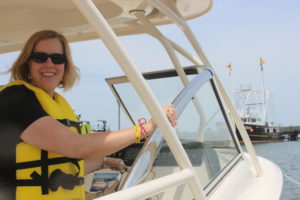This blog series continues to explore the incredible work being done by our partners in promoting boating and water safety across the world.

We’d like to introduce you to Gail Kulp, executive director of the Sea Tow Foundation. She received her master’s degree in educational policy, planning and leadership from The College of William & Mary and her bachelor’s degree from Salisbury University in elementary education and history. Gail is also a Certified Association Executive, a credential earned from the American Society of Association Executives. In her spare time, she enjoys kayaking, hiking, baking cookies, reading, photography, and scrapbooking. She lives in Pennsylvania with her husband, Chris, and their rescue dog, Rosie.
Gail shared what outreach looks like for the Sea Tow Foundation this year.
“The Sea Tow Foundation will continue their nationwide Life Jacket Loaner Program with over 750 life jacket loaner stations in operation across the country. The foundation is hoping to add another 50 or more to the count. The location of the loaner stands can be found on our interactive map at www.boatinsafety.com/map. Yellow pins note the location of Sea Tow Foundation life jacket loaner stands, and the purple pins show where boating safety friends have their own loaner stations. If you’re interested in hosting a life jacket loaner stand in your community, learn more at www.boatingsafety.com/lifejacketgrant.”
Gail shared some additional ways the Sea Tow Foundation is promoting boating and life jacket safety.
“The Sea Tow Foundation also provides a lot of resources to the boating community about safety and life jacket wear that are available for free. The first is our Infographic on How to Fit a Child with a Life Jacket that shows the step-by-step process to ensure proper fit. Our First Mate Checklist is another free resource that provides a great way to involve kids in the pre-departure checklist that should be done by all boaters. Lastly, the Sea Tow Foundation also maintains a robust and searchable blog at www.boatingsafety.com/blog on all sorts of boating safety topics including wearing an engine cut-off device, designating a sober skipper, how to use a VHF radio, and how to check the weather before heading out.”
Gail shared with us more about the Sea Tow Foundation’s position on safe boating and life jacket safety.
“The Sea Tow Foundation believes that boating can be safe AND fun, and that there is no reason why the two can’t go hand in hand. With our life jacket loaner program, we are constantly reminding boaters about the importance of having a properly fitted life jacket, and that they can borrow one for free whenever they need one either because they forgot to pack theirs, the kids outgrew their old ones, or because they invited more friends on board and didn’t have life jackets for them. We also have a Life Jacket Drive to collect new and gently used life jackets that can be repurposed on life jacket loaner stations in the same local areas as the donor as well as materials to help a local group run a life jacket drive collection event. Information is available at www.lifejacketdrive.org.”
Gail also shared about the impact of their life jacket loaner stands.
“While it is always difficult to quantify how many lives have been saved by loaning life jackets to boaters for free, the goal of the life jacket loaner stands is to see a reduction in the number of recreational boating deaths and unintentional drownings by providing recreational boaters and other citizens with life jackets. Often, boaters have near-drowning experiences and never report this to the life jacket loaner station hosts, but there are times when someone witnesses the event and reports the incidence. Ranger Miranda Peters at the U.S. Army Corps of Engineers Black Butte Dam and Lake in California reported the following incident to the Sea Tow Foundation in 2019:
A PWC capsized in the middle of the lake. The driver, wearing one of the loaner life jackets, was able to remain afloat in the water until the vessel could be righted and towed into shore. The individual was in the water for over 20 minutes and was able to keep his head above water because of the PFD. Without the use of the PFD, I feel certain the individual would have grown weak from treading water and most likely would have drowned.
Other successes are less obvious and are shown only after a number of years. For examples, at Kaw Lake in north-central Oklahoma, tragedy occurred twice in 2016 when two separate boating trips resulted in drowning deaths. On separate occasions, two men entered the water while boating without wearing their life jackets and neither one survived. In response, the park rangers at Kaw Lake wanted to ensure that these two men did not die in vain, so they applied for the Sea Tow Foundation’s Life Jacket Loaner Program in 2017 and built 4 life jacket loaner stations around the park. The Sea Tow Foundation provided the park with life jackets ranging in size from infant to adult, as well as the materials needed to host their life jacket loaner program. The park provided the materials and labor to build the stands. Four years later, Kaw Lake has not had any drowning incidents thanks to the Sea Tow Foundation’s Life Jacket Loaner Program which is credited with keeping their 500,000+ visitors safe each year.”
To close, Gail shared with us her top 2-3 safety tips for people who are looking to enjoy time on the water this summer:
“The first tip is to make sure that you have all of the required equipment on board that you need. This includes life jackets that fit properly and are worn, as well as sound producing devices. Depending on the type of boat or where you are boating, you may be required to have navigation lights, fire extinguishers, visual distress signals, and a sanitation waste disposal system as well. Second, always have a Sober Skipper on board who will ensure that the boat and everyone on board has a safe trip and arrives back to the dock (or land) safely. Third, always use an engine cut-off device when boating as long as your boat has an engine. Obviously, this is not a paddle-sports tip. For paddlers, our third tip would be to dress for the water temperature, not the air temperature.





